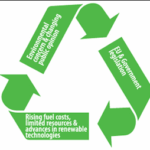
1. Introduction
Artificial intelligence (AI) is no longer a distant horizon—it is the defining feature of today’s economy. Across industries, from healthcare and logistics to finance and creative sectors, AI is accelerating change at a pace unmatched by previous technological revolutions. What distinguishes this moment is not only the magnitude of transformation but the speed and unpredictability with which it unfolds.
The impact on employment is already measurable. PwC (2023) estimates that nearly 30% of UK jobs could be automated by the mid-2030s. The World Economic Forum (2023) projects the loss of 83 million jobs globally by 2027, offset by the creation of 69 million new roles in data, AI, and sustainability. The International Labour Organisation (2023) adds a sharper warning: clerical and administrative roles—predominantly held by women—are at the highest risk of displacement. These figures underline a clear reality: jobs are not simply shifting, they are being redefined and redistributed across entirely new domains.
The strategic question, then, is less about whether AI will disrupt work—it already has—and more about how organisations and individuals position themselves in response. Firms that cling to rigid hierarchies risk obsolescence, while those that foster fluid, AI-human collaboration are likely to gain a competitive advantage. For individuals, the calculus is equally stark: fear displacement, or reskill to seize emerging opportunities.
Leaders frame this duality differently. Elon Musk warns of existential risk, even as he invests heavily in AI innovation. Sam Altman, CEO of OpenAI, emphasises augmentation over replacement—AI as a tool to unlock human potential. The late Steve Jobs, were he alive today, might argue that AI’s true power lies not in the technology itself but in its capacity to reshape how people “think different” and innovate.
This tension—between disruption and reinvention—defines the present era. The workforce is fragmenting into roles that vanish, roles that evolve, and roles that are only now being imagined. The decisive variable is adaptability. Success will depend on rethinking assumptions, reskilling workforces, and redesigning organisations for a new equilibrium between human intelligence (HI) and AI.
This article does not offer alarmist predictions nor empty optimism. Instead, it sets out a strategic roadmap: how to navigate the redefined world of work where AI is a permanent co-author of productivity, creativity, and value creation. The operative question is no longer “Will AI take my job?” but “How can I remain relevant in an AI-first economy?”
2. WHY AI IS UNLIKE ANY OTHER REVOLUTION
Technological revolutions have repeatedly altered the course of human labour. The steam engine mechanised production, electricity expanded productivity beyond daylight hours, and the internet flattened global communication and commerce. Each wave was disruptive, but crucially, each unfolded over decades. Societies, governments, and businesses had time to adapt, retool, and reinvent.
AI, however, is different. Unlike previous technologies that amplified physical strength or extended communication, AI challenges the very foundation of human intelligence—our ability to think, analyse, and create. This is not simply another industrial revolution; it is a cognitive revolution. And its disruption will be broader, faster, and deeper than anything humanity has faced before.
2.1 The Speed Factor: From Incremental to Exponential
Previous disruptions were generational. The telephone took 75 years to reach 100 million users. Electricity required nearly half a century to become mainstream. By contrast, AI adoption is unfolding at unprecedented speed. OpenAI’s ChatGPT reached 100 million users within two months of its launch in 2022—the fastest adoption curve in history. To put this in perspective, Instagram took 2.5 years to achieve the same milestone, while TikTok took 9 months. This exponential uptake not only underscores AI’s disruptive potential but also highlights how digital infrastructure, hyperconnectivity, and rising public curiosity have accelerated technology diffusion in the 21st century.
Each successive version of large language models (LLMs) now demonstrates leaps in capability that would once have taken years of research. GPT-4 solved standardised exams at near-human levels; generative models create functional code in seconds; multimodal systems now combine text, images, and audio seamlessly. This acceleration is what Elon Musk refers to when he warns that “AI moves at exponential speed, while regulators move at linear speed.” The tension is clear: institutions struggle to legislate, reskill, or adapt fast enough, while the technology evolves on a weekly cadence.
This pace of change is not only compressing adaptation timelines but also widening gaps between leaders and laggards. Organisations that experiment with AI today are developing compounding advantages in efficiency, insight, and innovation that will be difficult for late adopters to catch up to.
2.2 The Breadth Factor: AI Everywhere, All at Once
Whereas earlier technologies disrupted industries sequentially, AI is infiltrating all domains simultaneously.
- Healthcare: AI systems now outperform radiologists in detecting breast cancer at early stages, with some studies showing accuracy improvements of more than 10 percentage points over human benchmarks.
- Law: Startups like Harvey AI and Casetext draft contracts and conduct legal research faster than junior associates, reshaping billable work.
- Finance: AI-powered trading algorithms execute millions of micro-decisions in real time, creating strategies that human traders cannot match.
- Education: AI tutors are delivering personalised learning experiences, once possible only with one-on-one human instruction, lowering barriers to quality education.
Sam Altman, CEO of OpenAI, frames this breadth as the hallmark of a general-purpose technology—akin to electricity or the internet. But unlike those predecessors, AI’s reach is horizontal and immediate. Few, if any, sectors will be untouched.
2.3 The Depth Factor: Beyond Automation into Cognition
Traditional automation targeted manual or repetitive work: assembly-line tasks, bookkeeping, or data entry. White-collar roles that relied on creativity, strategic thinking, or emotional intelligence were widely considered “safe.” AI has shattered that assumption.
- Generative models now design logos, write stories, compose music, and even generate movie trailers.
- AI systems draft marketing campaigns, analyse corporate strategies, and propose new scientific hypotheses.
- DeepMind’s AlphaFold solved the protein-folding problem—a biological puzzle that eluded scientists for 50 years—unlocking breakthroughs in drug discovery.
Steve Jobs once described computers as “bicycles for the mind”—tools to help humans think faster. AI, however, is not a bicycle. It is fast becoming a co-pilot for cognition, performing tasks once believed to be uniquely human. This is the true depth of disruption: AI is not only replacing hands. It is beginning to challenge minds.
2.4 Shockwaves in the Job Market
The effects on employment are already measurable. A 2023 Goldman Sachs report estimated that AI could automate the equivalent of 300 million full-time jobs worldwide. Middle-class, routine professions—customer service, paralegal research, data analysis—face the highest risk. Ironically, jobs once seen as secure due to their intellectual requirements are now among the most exposed.
At the same time, new categories of work are emerging. Demand for “prompt engineers” has surged, with some earning six-figure salaries to design effective AI instructions. AI ethicists, algorithm auditors, and human–AI collaboration specialists are also becoming critical roles. Yet these new opportunities will not replace, one-for-one, the millions of jobs displaced. The transition will be uneven and disruptive, particularly for workers in mid-skill, routine cognitive roles.
History suggests that labour markets eventually rebalance after technological shocks. But the velocity of AI disruption raises the risk of long-term dislocation, especially for workers unable to retrain quickly. Policymakers, employers, and individuals alike will need to treat reskilling not as a “nice to have,” but as an economic imperative.
2.5 Visionary Perspectives: Crisis or Catalyst?
The leading voices in technology frame AI’s disruption in starkly different ways:
- Elon Musk views AI as both an existential threat and the greatest accelerator of progress, warning, “Mark my words, AI is far more dangerous than nukes.”
- Sam Altman emphasises augmentation, not replacement: humans set goals, AI accelerates execution. His optimism: “Most jobs will change, but new jobs—unimaginable today—will emerge.”
- Steve Jobs, were he alive today, would likely frame AI as a call for reinvention. In his spirit: “The tragedy is not the disruption itself, but our failure to reinvent in response to it.”
Despite divergent tones, these perspectives converge on one truth: denial is not an option. AI is not waiting for societies, regulators, or individuals to be ready. Its disruption is here—sweeping across industries, professions, and geographies at once.
What distinguishes AI from revolutions before it is not simply its speed, breadth, or depth. It is that it disrupts the essence of human work: thinking itself. The question is no longer whether machines can think like humans. The real test is whether humans can adapt, reskill, and reinvent quickly enough to remain relevant in an AI-driven economy.
3. WHY SOME JOBS ARE MORE VULNERABLE THAN OTHERS
Public debate around AI and jobs often paints the risk in broad strokes, yet the reality is more nuanced. Not all roles face the same level of exposure, and understanding these differences is critical for workers, businesses, and policymakers. Vulnerability depends less on whether a profession is “white-collar” or “blue-collar,” and more on the underlying tasks that define the work—specifically, how easily those tasks can be translated into machine-executable routines.
3.1 The Automation Spectrum
Work exists on a spectrum of automability. At one end are roles composed largely of predictable, routine tasks. These are the easiest for AI to take over because machines thrive on repeatability and structured data. For example, data entry, payroll processing, and scripted customer service can be codified into algorithms or machine learning models with relative ease.
At the other end are jobs demanding human judgment, emotional intelligence, and situational awareness—counselling, creative direction, or emergency response. While AI can augment these roles, it cannot fully replicate the empathy, intuition, and contextual decision-making that humans bring.
3.2 Determinants of Job Vulnerability
Several factors shape whether a role is at high or low risk of automation:
- Task Routine-Intensity: McKinsey (2022) estimates that nearly 50% of work activities globally could be automated using currently available technologies. Routine-heavy roles such as telemarketing, bookkeeping, and administrative support are especially exposed. The more standardised the task, the more easily it can be handed to machines.
- Cognitive vs. Manual Divide: Contrary to popular belief, white-collar jobs are not necessarily safer than manual trades. AI can draft legal contracts, summarise case law, and analyse financial reports faster than entry-level professionals. By contrast, it is far more difficult to automate the fine motor skills and contextual judgment needed to repair plumbing, install wiring, or provide emergency medical support.
- Data Intensity: Jobs in finance, logistics, and customer service, which depend heavily on large volumes of structured data, are particularly susceptible. Professions rooted in tacit knowledge, improvisation, or contextual nuance—like teaching, artisanal craftsmanship, or construction—face less immediate disruption.
- Regulatory and Ethical Barriers: Technological capability alone does not guarantee adoption. In healthcare, for example, AI already detects certain cancers with accuracy rivalling or exceeding radiologists. Yet regulatory approval processes, liability concerns, and the ethical need for human oversight slow down full-scale substitution.
3.3 Case Illustrations
- Legal Research Assistants: AI-powered platforms can scan thousands of case files in seconds, reducing the demand for junior associates to spend long hours on research. This threatens the traditional apprenticeship model that has long defined career progression in law firms.
- Radiology vs. Nursing: AI models increasingly outperform radiologists at identifying patterns in medical scans. In contrast, nursing—requiring empathy, physical care, and patient interaction—remains far more resistant to automation.
- Creative Professions: AI-generated art, scripts, and music have demonstrated how automation can extend even into creative industries. Yet originality, taste, and the ability to tell stories with cultural and emotional resonance remain human strengths.
3.4 The Emerging Irony
One of the more striking dynamics of the AI era is the reversal of perceived job security. Professions once seen as prestigious and insulated—such as mid-tier legal, financial, and clerical roles—are suddenly among the most at risk. Meanwhile, roles long considered less prestigious, including plumbers, electricians, chefs, and caregivers, may prove more resilient. Far from being “low-status,” these trades may rise in value as their human-centric skills remain difficult to automate.
3.5 Big-Picture Insight
AI is not simply eliminating jobs; it is reshaping the hierarchy of skills and professions. Routine intellectual work—once prized in the knowledge economy—is increasingly replicable. In its place, adaptive human skills are becoming the foundation of resilience: creativity, empathy, ethical judgment, problem-solving, and manual expertise.
The challenge for workers, then, is not only to avoid redundancy but to actively identify where their human uniqueness creates irreplaceable value. For organisations and policymakers, the imperative is to design systems that support reskilling at scale, ensuring that workers can pivot toward roles where human strengths complement rather than compete with AI.
4. FOR INDIVIDUALS, BUSINESSES, AND GOVERNMENTS
AI’s disruption is not a wave you can ride passively; it’s a tide reshaping the shoreline. Survival — and success — requires coordinated reinvention across individuals, businesses, and governments.
4.1 For Individuals: Rethink, Reskill, Reinvent
- Adopt a Lifelong Learning Mindset: Jobs argued that “stay hungry, stay foolish” was not a slogan but a survival skill. Education can no longer end with a degree. Individuals must continuously retool through micro-credentials, bootcamps, and AI-powered learning platforms.
- Prioritise Human-Centred Skills: Creativity, empathy, emotional intelligence, and complex problem-solving remain irreplaceable. Musk’s warning is stark: “If it can be automated, it will.” Humans must therefore double down on what cannot.
- Reskill with Agility: Altman stresses adaptability. Workers should pursue hybrid skills — “AI + finance,” “AI + healthcare,” “AI + law” — to stay market-relevant in dynamic ecosystems.
- Build a Personal AI Strategy: Treat AI tools as Jobs’ “bicycles for the mind” — amplifiers of human potential, not replacements. Use them for productivity, from content creation and coding assistants to decision support and data analysis.
4.2 For Businesses: Reinvent or Become Obsolete
- Integrate AI into the Core Strategy: Musk cautions against “bolting AI on the side.” Winning firms embed AI into supply chains, predictive analytics, customer personalisation, and R&D — making it their operating system, not an accessory.
- Invest in Human-AI Collaboration: Altman emphasises alignment. Businesses must train employees to work with AI, not against it, deploying augmentation tools while reskilling teams for higher-value roles.
- Foster an Innovation Culture: Jobs thrived where technology met the liberal arts. Businesses must emulate this by rewarding creativity, tolerating failure, and encouraging experimentation.
- Make Ethics and Trust a Competitive Edge: In a world sceptical of AI’s consequences, fairness, transparency, and accountability in AI adoption are not just compliance issues; they are brand differentiators. Trust will be the new currency of competitive advantage.
4.3 For Governments: Regulate and Reimagine
- Proactive Regulation, Not Reactive Bans: Musk warns of AI’s existential risks. Governments should build anticipatory frameworks, AI safety standards, risk classifications, and explainability mandates to pre-empt crises.
- Launch National Reskilling Missions: Altman insists that equitable access to AI literacy will determine who wins the next industrial revolution. Large-scale retraining programs must become state priorities.
- Provide Social Safety Nets for Transition: Universal Basic Income (UBI), AI dividends, and wage subsidies should be tested to protect workers displaced by automation. Musk champions UBI as a realistic response to technological unemployment.
- Invest in AI Infrastructure: Like venture capitalists, governments must fund AI research hubs, national cloud computing infrastructures, and STEM pipelines. This is not expenditure; it is a bet on future competitiveness.
This tri-level strategy—personal reinvention, business transformation, and government foresight– forms the blueprint for thriving in an AI-driven world. But blueprints alone do not build bridges; only courage and execution will decide whether societies collapse under disruption or rise with resilience.
Despite the accelerating dominance of artificial intelligence, there remain profoundly human qualities that machines cannot replicate. While algorithms excel at data processing, prediction, and pattern recognition, they lack the depth of creativity, emotional intelligence, and moral reasoning that define the human experience. These qualities, uniquely human and deeply irreplaceable, will shape the future of work.
5.1 Creativity and Imagination
Steve Jobs once reminded the world that “technology alone is not enough.” True breakthroughs happen when technology is fused with the liberal arts and humanities to create outcomes that “make our hearts sing.” AI can generate paintings, compose music, or produce text, but it does so by recombining patterns within existing data. Humans, by contrast, draw from lived experiences, intuition, and imagination to birth ideas that transcend data. The leap from typewriters to personal computers was not simply incremental progress—it was the work of visionary imagination. Creativity, therefore, remains the frontier where humans outpace machines.
5.2 Emotional Intelligence (EQ)
Sam Altman, a leading voice in AI, has often emphasised that while machines can simulate responses, they cannot empathise. Empathy—the ability to interpret unspoken signals, understand motivation, and build trust—remains a human advantage. Professions in leadership, healthcare, counselling, diplomacy, and negotiation rely on trust, nuance, and human connection. In these domains, emotional intelligence is not an accessory; it is the product itself. Machines may provide support, but they cannot embody the vulnerability, compassion, and authenticity that human-to-human interaction requires.
5.3 Ethics, Judgment, and Values
Elon Musk has repeatedly warned that without moral frameworks, AI could become dangerous. Machines are bound by algorithms; they cannot weigh morality, values, or the societal implications of decisions. Human judgment is required to navigate uncertainty, balance risk with ethics, and safeguard collective well-being. For example, deciding how to allocate scarce healthcare resources during a pandemic is not a matter of mathematical optimisation—it is a profoundly ethical choice that considers fairness, dignity, and humanity. In an AI-driven age, ethical reasoning is not a luxury but a responsibility that only humans can shoulder.
5.4 Lifelong Learning and Adaptability
Another distinctive human advantage lies in adaptability and lifelong learning. Humans possess meta-learning—the ability to reinvent themselves as conditions evolve. Unlike algorithms that must be retrained with vast datasets, humans can pivot careers, acquire new skills, and thrive in uncharted environments with limited inputs. This resilience in the face of disruption is what enables societies and individuals to flourish when confronted with uncertainty. In the age of constant technological upheaval, adaptability becomes not just an advantage but a necessity.
The future of work is not about competing with AI on speed or efficiency. It is about amplifying the uniquely human traits—creativity, emotional intelligence, ethical reasoning, and adaptability—that machines cannot replicate. The more deliberately we cultivate these qualities, the more irreplaceable we become. AI may shape the infrastructure of the future, but it is humanity’s distinctiveness that will shape its soul.
AI is not eliminating work wholesale, but it is reshaping it at scale and speed. The challenge is no longer whether disruption will come, but how individuals can position themselves to thrive rather than merely survive. Reinvention is not optional; it is the new baseline for professional relevance. This section offers a structured roadmap—actionable strategies that workers, regardless of industry or seniority, can use to future-proof their careers.
6.1 Rethink: Shift Your Mindset
- Accept disruption as reality: The first barrier to reinvention is denial. Clinging to the belief that “my job is safe” delays necessary adaptation.
- Adopt a growth mindset: Treat AI not as a rival but as a tool to extend human capacity. Research in organisational psychology shows workers who view change as an opportunity are more likely to advance during disruption (Dweck, 2020).
- Example: Instead of resisting AI-driven analytics in marketing, learn to interpret and apply insights in ways competitors cannot—turning the tool into an advantage.
6.2 Reskill: Acquire Future-Ready Skills
Future resilience will rest on hybrid capabilities—a fusion of technical fluency and human-centred strengths. Priority skill clusters include:
- Digital Fluency: Understanding the fundamentals of AI, automation, and data ecosystems.
- Critical Thinking: The ability to interrogate AI outputs, identify embedded biases, and make informed decisions.
- Interpersonal Skills: Empathy, leadership, and negotiation—skills where machines lag.
- Sustainability and Systems Thinking: With ESG and climate imperatives rising, professionals who align AI to broader human and environmental goals will be indispensable.
Governments and corporations are already investing in large-scale upskilling. Microsoft’s Global Skills Initiative, for instance, has trained over 30 million people worldwide since 2020. These programs signal a global pivot toward AI literacy as an economic necessity.
6.3 Reinvent: Redefine Your Professional Identity
- From Career Ladders to Career Portfolios: Linear careers in a single profession are giving way to dynamic, portfolio-style journeys where multiple roles and skills accumulate into resilience.
- Embrace Continuous Learning: Micro-credentials, MOOCs, and industry certifications provide flexible, low-cost options for reskilling.
- Experiment and Pivot: Waiting for disruption is risky; exploring adjacent roles and industries builds adaptability.
- Example: A logistics manager might transition into a supply chain data strategist, blending operational expertise with AI-driven optimisation.
6.4 Leverage AI as a Partner, Not a Rival
- Learn to co-pilot with AI: Use generative models for drafting, coding assistants for software, and predictive models for planning.
- Augmented roles will dominate: The highest-value careers will be those where humans and machines collaborate, producing outcomes faster and smarter than either could alone.
- Mindset shift: The critical question is not, “How do I compete against AI?” but, “How do I use AI to extend my human edge?”
6.5 Network and Collaborate Across Disciplines
- Build bridges beyond your sector: AI is not confined to technology—it is transforming law, healthcare, logistics, education, and the arts.
- Cross-disciplinary fluency builds resilience: A teacher who incorporates AI into pedagogy or a lawyer who masters AI-assisted research will stand out.
- Example: In Ghana, farmers are blending AI with indigenous knowledge to predict rainfall and optimise harvests—demonstrating how collaboration across tradition and technology drives resilience.
6.6 Adopt Resilience Practices
Reinvention is not purely technical; it requires emotional stamina. Practices that sustain resilience include:
- Mindfulness and reflection to navigate uncertainty without burnout.
- Peer-learning communities to build shared accountability and momentum.
- Personal innovation labs—side projects, freelance work, or research—that keep skills fresh and foster adaptability.
Survival in the AI era cannot be outsourced to policymakers or employers. Reinvention is personal. By rethinking assumptions, reskilling continuously, and reinventing identities, individuals can transform disruption into opportunity. The workforce of the future will not be defined by machines replacing humans, but by humans who harness machines to amplify what makes them uniquely irreplaceable.
7. Future of Work – From Human–AI Rivalry to Human–AI Symbiosis
For much of the public debate, AI and employment have been cast in adversarial terms—a contest of survival between human labour and machine intelligence. This framing is misleading. Historically, technological leaps—from the steam engine to the internet—have not eradicated work but reshaped it, displacing routine tasks while expanding human capability in entirely new domains. AI is no different; what distinguishes it is the unprecedented velocity, scope, and scale of change.
7.1 Moving Beyond the Fear of Replacement
Anxieties that “AI will take all jobs” echo the Industrial Revolution’s Luddite fears. In reality, automation will primarily erode repetitive, rule-based tasks, while amplifying demand for roles defined by creativity, empathy, adaptability, and complex problem-solving. The question is not whether AI will replace humans, but how humans can leverage AI to extend their own capacity and impact.
7.2 Human–AI Symbiosis: The Collaborative Paradigm
The frontier of value creation lies in collaboration, not competition, between humans and machines:
- AI as a Co-Pilot – From GitHub Copilot to ChatGPT, AI augments human productivity by automating execution and surfacing insights, enabling humans to focus on higher-order thinking.
- Amplifying Human Potential – Physicians using AI for diagnosis, engineers deploying AI for simulation, and designers experimenting with generative models demonstrate the multiplier effect of human–machine partnership.
- Redefining Work Itself – Jobs are evolving from static roles to dynamic portfolios of tasks, continuously reshaped by what AI can enhance rather than replace.
7.3 The Rise of New Human-Centred Skills
Competitive advantage in the AI era will accrue to individuals and organisations that cultivate distinctly human capabilities while mastering AI fluency:
- Meta-Cognition: The discipline to reflect on and refine one’s thinking while directing AI execution.
- Ethical Judgment: Anchoring AI-driven decisions in fairness, responsibility, and accountability.
- Interdisciplinary Integration: Bridging technical expertise with social sciences, arts, and ethics to ensure responsible, contextualized deployment of AI.
7.4 Rethinking Organisational Models
The legacy structures of the 20th century—hierarchical, efficiency-maximising, and rigid—are ill-suited for human–AI symbiosis. Organisations must evolve toward:
- Agile, Cross-Functional Teams that adapt in real time to AI-powered insights.
- Continuous Learning Cultures where reskilling and reinvention are embedded, not episodic.
- Human–AI Governance where boards oversee not only financial stewardship but also AI ethics, transparency, and alignment with societal values.
7.5 Towards a Symbiotic Future
The past decade was defined by machines learning from humans. The coming decade will be defined by humans learning to thrive with machines. In this symbiotic future, AI does not diminish what makes us human; it magnifies it. Creativity, empathy, curiosity, and vision will become the enduring sources of differentiation—precisely because they cannot be replicated by algorithms.
8. CONCLUSION: ONE MORE THING
Every revolution redraws the boundaries of work, leaving behind two groups: those who resist change and those who harness it. The AI revolution will be no exception. Machines are not simply here to replace tasks—they are here to stretch us, to test our adaptability, and to accelerate our evolution toward higher-value roles.
From Elon Musk’s warnings on existential risks to Sam Altman’s optimism about human reinvention, and Steve Jobs’ reminder that technology matters only when it serves humanity, the message converges: the future of work will not be dictated by algorithms, but by the choices we make in this moment.
This is not an era for hesitation. It is an era for decisive courage. Courage to unlearn and relearn at speed. Courage to leave behind the comfort of legacy skills and embrace the uncertainty of new frontiers. Courage to see AI not as a rival, but as a multiplier of our most distinct human qualities—creativity, empathy, ethical judgment, and leadership.
The challenge ahead is not about racing machines. It is about becoming more human than ever before. That is both the paradox and the promise of the AI age.
And one more thing: history will not remember those who merely resisted AI. It will celebrate those who reimagined work, redesigned institutions, and redefined what it means to be human in a machine-driven world. Be that person. Be that leader. Be that future.
DISCLAIMER: The Views, Comments, Opinions, Contributions and Statements made by Readers and Contributors on this platform do not necessarily represent the views or policy of Multimedia Group Limited.
DISCLAIMER: The Views, Comments, Opinions, Contributions and Statements made by Readers and Contributors on this platform do not necessarily represent the views or policy of Multimedia Group Limited.
Source: myjoyonline.com










